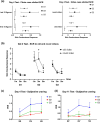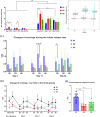Exploring Post-Retrieval Strategies to Reduce Drug Craving in Methamphetamine Use Disorders
- PMID: 40536786
- PMCID: PMC12178206
- DOI: 10.1111/adb.70049
Exploring Post-Retrieval Strategies to Reduce Drug Craving in Methamphetamine Use Disorders
Abstract
Post-retrieval interventions based on memory reconsolidation have shown promise in reducing addiction-related memories. However, research on methamphetamine (MA) use, particularly in humans, remains limited. This study aimed to evaluate the efficacy of a post-retrieval intervention paradigm in managing methamphetamine use disorder (MUD) with 46 individuals from a compulsory drug rehabilitation centre. A single-blind design was employed, with participants randomly assigned to one of three groups: (1) retrieval-no intervention, (2) retrieval-extinction and (3) retrieval-cognitive task. The study involved baseline testing, followed by memory retrieval using MA cues, and one of the three interventions during the memory reconsolidation window. The interventions were as follows: (1) no further intervention after retrieval, (2) extinction training and (3) playing Tetris after memory reactivation. Relapse was assessed through physiological and psychological indicators, with a focus on both spontaneous and cue-induced relapse of MUD memory. The results showed that both retrieval-extinction and retrieval-cognitive task showed benefits in reducing cravings and preventing relapse in MUD compared to retrieval alone. Physiological and psychological indicators of MA memory relapse showed weak correlation and differed across several dimensions. These findings suggest new strategies for MUD intervention and provide valuable insights for clinical treatment. Limitations of the study are also discussed.
Keywords: cognitive task; craving; methamphetamine use disorder; post‐retrieval intervention; retrieval–extinction.
© 2025 The Author(s). Addiction Biology published by John Wiley & Sons Ltd on behalf of Society for the Study of Addiction.
Conflict of interest statement
The authors declare no conflicts of interest.
Figures






Similar articles
-
Effect of conditioned stimuli-triggered memory retrieval-extinction in patients with methamphetamine use disorder.Transl Psychiatry. 2025 Jul 18;15(1):249. doi: 10.1038/s41398-025-03474-5. Transl Psychiatry. 2025. PMID: 40681501 Free PMC article. Clinical Trial.
-
Effect of inhibition of reactivated alcohol-associated memories with propranolol on alcohol craving.BMC Psychiatry. 2025 May 6;25(1):453. doi: 10.1186/s12888-025-06904-2. BMC Psychiatry. 2025. PMID: 40329212 Free PMC article. Clinical Trial.
-
Benefits of acute aerobic exercise to ameliorate craving and risky decision-making in individuals with methamphetamine use disorder.Drug Alcohol Depend. 2025 Sep 1;274:112735. doi: 10.1016/j.drugalcdep.2025.112735. Epub 2025 May 30. Drug Alcohol Depend. 2025. PMID: 40472714 Clinical Trial.
-
Selegiline for Alzheimer's disease.Cochrane Database Syst Rev. 2003;(1):CD000442. doi: 10.1002/14651858.CD000442. Cochrane Database Syst Rev. 2003. PMID: 12535396
-
Incentives for preventing smoking in children and adolescents.Cochrane Database Syst Rev. 2017 Jun 6;6(6):CD008645. doi: 10.1002/14651858.CD008645.pub3. Cochrane Database Syst Rev. 2017. PMID: 28585288 Free PMC article.
References
-
- Daiwile A. P., McCoy M. T., Ladenheim B., Subramaniam J., and Cadet J. L., “Incubation of Methamphetamine Craving in Punishment‐Resistant Individuals Is Associated With Activation of Specific Gene Networks in the Rat Dorsal Striatum,” Molecular Psychiatry 29, no. 7 (2024. Jul): 1990–2000. - PMC - PubMed
-
- Tolliver B. K., McRae‐Clark A. L., Saladin M., et al., “Determinants of Cue‐Elicited Craving and Physiologic Reactivity in Methamphetamine‐Dependent Subjects in the Laboratory,” American Journal of Drug and Alcohol Abuse 36, no. 2 (2010): 106–113. - PubMed
-
- Milton A. L., Das R. K., and Merlo E., “The Challenge of Memory Destabilisation: From Prediction Error to Prior Expectations and Biomarkers,” Brain Research Bulletin 194 (2023. Mar): 100–104. - PubMed
Publication types
MeSH terms
Substances
Grants and funding
- 32000752/National Natural Science Foundation of China
- 32371137/National Natural Science Foundation of China
- 32200899/National Natural Science Foundation of China
- GD24CXL02/Philosophy and Social Sciences Planning Project of Guangdong Province
- GD23XXL15/Philosophy and Social Sciences Planning Project of Guangdong Province
LinkOut - more resources
Full Text Sources
Medical

